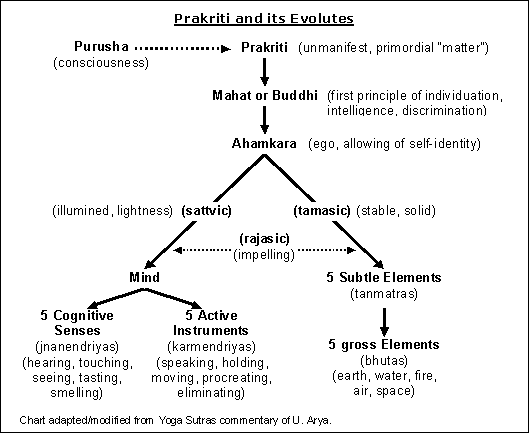If you’ve ever heard the words Purusha and Prakriti being casually tossed around by social media influencers or spiritual gurus (aren’t they basically the same thing these days?), you’re about to meet the philosophy that first gave these terms real depth. Samkhya, founded by Sage Kapil, is the oldest dualistic school among the orthodox Indian Darshanas. It’s mentioned directly in Vyasa’s Mahabharata and the Bhagavad Gita, which shows just how ancient and influential it is.
Samkhya laid the groundwork for many other spiritual and philosophical traditions that came after it, such as Yoga in Patanjali’s Yoga Sutras, Vedanta like Shankaracharya’s interpretation, and even Tantra like Kashmiri Shaivism. Each of these tried in their own way to address what they saw as gaps or tensions in Samkhya. That is why understanding Samkhya is important. It helps you see where these other systems are coming from. In fact, when Krishna begins his teaching in the second chapter of the Bhagavad Gita, the first philosophy he presents to Arjuna is Samkhya. After all, the word Samkhya itself means the right knowledge.
At its core, Samkhya explains the evolution of the entire world, or Jagat, through the interaction of two eternal, fundamental, and independent realities: Prakriti and Purusha. Both are considered equally real, which is why Samkhya is known for its dualistic realism. Purusha is pure consciousness. It is the intelligent witness that does not act, does not suffer, and is beyond space, time, pain, pleasure, bondage, and even liberation. Consciousness is not something Purusha has. Purusha is consciousness.
Samkhya argues that an immaterial, inactive, and conscious substance like Purusha cannot be the cause of this active, material, and unconscious world. It also holds that atoms cannot be the ultimate cause either, because they cannot explain the more subtle aspects of reality such as intelligence, consciousness, ego, and mind.
According to Samkhya, the cause of any effect must be subtler than the effect itself. For example, the cause of a tree is a seed, which is smaller and more subtle than the tree. So we need something even subtler than atoms, mind, intellect, and ego to account for the origin of everything in the world. That subtlest, primordial matter, which is the cause of the entire world, is called Prakriti. Prakriti is so subtle that it cannot be perceived. It is the ever-active, unconscious, and unintelligent reality.
Prakriti has three inseparable aspects, known as the three gunas:
- Sattva Guna (Essence of clarity): It is light and bright, buoyant and illuminating. Pleasure, happiness, contentment, bliss, and upward movement all arise from it.
- Rajas Guna (Essence of impulse): It brings about restless activity, feverish effort, and intense stimulation.
- Tamas Guna (Essence of inertia): It is the principle of heaviness and inertia. It leads to apathy and indifference, ignorance, confusion, passivity, and negativity. It is heavy and enveloping, and stands in opposition to sattva and rajas.
The gunas are not parts or attributes of Prakriti, because Prakriti is partless. Just like a rope is nothing more than three strands intertwined, Prakriti is nothing but the three gunas woven together. This is why it is called Trigunatmaka. In its natural state, known as Samyavastha, the gunas exist in dynamic equilibrium. They do not interfere with one another and remain in harmony, even though they can undergo transformation within themselves. You can think of it like the surface of a calm ocean, which appears still on the outside even though there is constant movement in the deeper layers below.
This state of equilibrium, which is the natural condition of Prakriti, becomes disturbed when Prakriti comes into proximity with Purusha. At that point, the gunas begin to intermingle and dominate one another. This stirring of the gunas is known as Gunashobha. It marks the starting point of the world, a condition called Vishamavastha. According to Samkhya, everything that evolves from Prakriti contains all three gunas. However, the proportions vary. Some things are more Sattvik, while others are more Rajasik or Tamasik. The only entity that exists beyond the three gunas is Purusha, which is called Trigunatita.
Gunashobha gives rise to the first transformation of Prakriti, known as Mahat, or cosmic intelligence. It is predominantly Sattvik in nature, which is why it is luminous. Mahat can be understood as the cosmic order and harmony that we observe in the world. The regularity of natural patterns, such as the rhythm of time, or the natural laws we observe, like gravity, are expressions of this cosmic intelligence. This cosmic intelligence is not consciousness, because consciousness can only come from Purusha. We will see later how the psychological aspect of this cosmic intelligence becomes active when it begins to function for a consciousness.
From this intelligence arises the cosmic ego, known as Ahamkar. This is the seed that generates the psychological sense of “I” and “mine.” Like Mahat, Ahamkar also has both a cosmic and a psychological aspect. The psychological aspect requires consciousness in order to function, which Prakriti alone cannot provide.
From the Sattvik Guna of cosmic Ahamkar come the mind, the five sense organs, and the five motor organs. The Tamasik Guna of the cosmic Ahamkar evolves into the five subtle elements, which then evolve into the five gross elements, namely earth, air, water, fire, and space. The Rajasik aspect of cosmic Ahamkar supplies the energy that enables the Sattvik and Tamasik aspects to evolve.

Since Prakriti itself is unconscious, all its evolutes are unconscious as well. Samkhya considers intelligence, ego, and mind to be material and unconscious too. So how are individuals conscious then? The same way moon is reflected from the waves in an ocean, Purusha is reflected in Mahat, which is luminous because of its predominantly Sattvik nature. When this happens, the reflection of Purusha causes the intelligence, Mahat, to become aware.

Think of Mahat as the first layer of the ocean, Ahamkar or ego as the layer underneath, and the mind, which is the Sattvik evolute of ego, as the layer below that. Since Sattvik evolutes are light, they stay closer to the surface, while Tamasik evolutes, being heavy, lie in the deepest layers. The light from the moon can only illuminate the ocean up to a certain depth. Similarly, Purusha’s reflection is able to illuminate only the Sattvik evolutes of Prakriti, which are lighter and closer to the surface of the ocean.
With Purusha’s reflection, the psychological aspects of Mahat and Ahamkar become active. It is like a computer program, such as a Python script, which exists passively on a computer when unused. Once it is given computing resources and a compiler or an interpreter, it starts performing tasks like fetching data and running AI models. In this way, conscious beings, also called Saupadika Purushas or Jivas, come into existence according to Samkhya.
The Tamasik evolutes of the cosmic ego are so solid that they cannot be illuminated or influenced by Purusha’s reflection. Thus, the five gross elements form the material world we see around us, but they themselves arise without any consciousness. It is important to note that Purusha and Prakriti are not gods. Sage Kapil was very clear that there is no God who generates (G), operates (O), and destroys (D) the world. The world evolves and dissolves simply because Prakriti and Purusha come into proximity and then separate. Yet, in the Bhagavata Purana, Kapil Muni is depicted as an incarnation of Vishnu.
Jivas are merely reflections of Purusha. Pure consciousness is their true nature, not Prakriti. Due to ignorance, they start identifying themselves with the intellect, ego, and mind, and become attached to the material things of the world. These material things cause jivas to experience pleasure and pain because of the three Gunas within them. Jivas become entangled in the world, and their sense of self comes from Prakriti. For example, when someone introduces themselves, their introduction is usually about where they work, where they live, their age, where they grew up, and their hobbies. For Samkhya, this is bondage.
Samkhya also provides a way out of this bondage. For liberation, we only need to realize our true nature. We must understand that we are Purusha and not Prakriti. We are beyond space and time, beyond pleasure and pain, and beyond the three Gunas. This discriminative knowledge, called Viveka Jnana, comes only after contemplating on self versus the non-self. All actions or karmas (good, bad, or neutral) and their reactions are products of Prakriti. Liberation lies beyond the three Gunas, and therefore no action or karma can lead the jiva to liberation.
Bondage in Samkhya is like being in a dark room. We don’t have to do any karma or action to light up the room. We just have to open our eyes to see that the room was always lit and the darkness was only because our eyes were closed. Ignorance makes us feel trapped in bondage, but as soon as we realize our true nature, that ignorance disappears, and we see that we were always free. According to Samkhya, this knowledge is not just a dry belief or faith that we are Purusha. It is a realization that dawns after consistent contemplation (Jnana Yoga) on our true nature. It is an insight, not a conceptual fact.
Socrates also gave great importance to knowledge. He believed that all actions we consider wrong come from ignorance, and once we remove this ignorance with the right knowledge, all our actions will be right. This idea is summarized in his famous quote “Knowledge is virtue.” He meant this in an ethical sense, not a metaphysical or spiritual one. Samkhya also believes that when we gain knowledge of our true self, all our actions become dispassionate and equanimous, which makes them non-binding. Since Purusha is our true nature and he is beyond pleasure and pain, beyond bliss and misery, we become equanimous once we realize our real self.
Aristotle’s concept of God is quite similar to the Purusha of Samkhya. Both represent pure intelligence, the ultimate goal toward which all creation evolves, and neither actively participates in the workings of the world.
Like all philosophies, this darshan has its flaws and critics have challenged it from many angles. The main criticism is this: Purusha cannot move because it is unconscious, and Prakriti can’t have a reason to approach Purusha as she is unintelligent and unconscious, then how do the two come into proximity? Also, how can an unconscious and unintelligent Prakriti be the source of intelligence (Mahat)? Furthermore, Prakriti is not completely independent since it requires Purusha to evolve into the world and to dissolve it again.
Despite the criticism, we can’t help but appreciate that Samkhya, one of the oldest Indian philosophies (which itself predates Western philosophy) does not explain the evolution of the world through a God. Like modern science, its entire cosmology is built without a creator or divine command. According to Samkhya, the world unfolds through natural laws and the principle of cause and effect. Unlike science, however, its view of evolution is teleological rather than mechanical. Samkhya offers a path to liberation that does not depend on praying, devotion, blind faith, or empty rituals. The respect and high stature given to Sage Kapil suggest that in the past, there may have been more tolerance toward differing views than we often see today.
Samkhya doesn’t ask you to believe. It asks you to see for yourself. Liberation, according to it, is not a miracle, a blessing, or an achievement. It is a realization.
Thanks for reading!